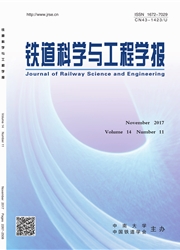

 中文摘要:
中文摘要:
采用分离涡模拟(DES)方法,对缩比为1:8且考虑受电弓设备(受电弓及“浴盆式”导流罩)的高速列车列车风特性进行研究。研究结果表明:数值计算结果与风洞试验数据吻合较好,尤其是较好网格列车各部分气动阻力系数均与风洞试验结果一致,误差在4%以内。列车风峰值主要出现在流线型头部、受电弓设备及近尾流区域,列车风速度及湍流度在距离轨面及车体表面越近的位置波动较大。“浴盆式”导流罩对受电弓基座部分减阻效果较明显,但其也是受电弓侧部列车风峰值出现的主要原因。受电弓及导流罩周围的空气绕流作用使沿车顶的边界层分离并产生涡脱落,是受电弓及其附属设备产生较大气动阻力的原因。
 英文摘要:
英文摘要:
Based on detached-eddy simulation (DES) , the slipstream of a 1: 8th scaled train model with panto-graph system (pantograph and closed-up flow guide) was investigated. Results shows that, numerical results fit well with the wind tunnel data , especially for drag coefficients obtained from fine grids are all within 4 % of each train part to wind tunnel data. The peak values of slipstream around train are mainly occurred at streamline head, pantograph system and near wake region. The fluctuation of slipstream and turbulence intensity is relatively higher when nearer top of rail and rain surface. The closed-up flow guide has a significant influence on the drag-reduc-tion of pantograph base. However, the peak value of slipstream at side part of train is mainly due to the circumfluence of closed-up flow guide. Due to the interruption of pantograph system to the flow on top of train, bounda-ry layers are separated and generated vortex structures, which explains relatively high aerodynamic drag of panto-graph as well as its belongings.
 同期刊论文项目
同期刊论文项目
 同项目期刊论文
同项目期刊论文
 Forecasting models for wind speed using wavelet, wavelet packet, time series and Artificial Neural N
Forecasting models for wind speed using wavelet, wavelet packet, time series and Artificial Neural N Comparison of new hybrid FEEMD-MLP, FEEMD-ANFIS, Wavelet Packet-MLP and Wavelet Packet-ANFIS for win
Comparison of new hybrid FEEMD-MLP, FEEMD-ANFIS, Wavelet Packet-MLP and Wavelet Packet-ANFIS for win 期刊信息
期刊信息
